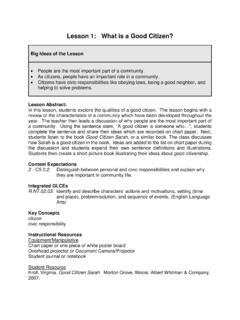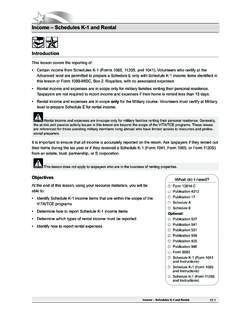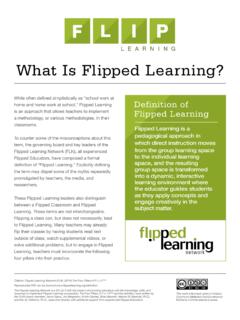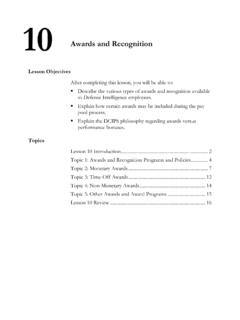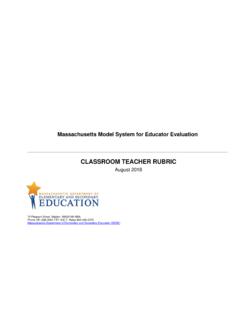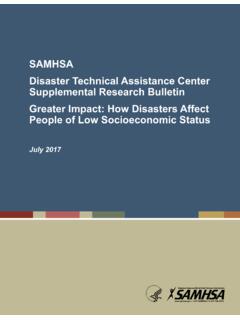Transcription of Make Your Own Project-Based Lesson Plan
1 Instructions based on the five-concept template created by Leecy Wise for Star School teachers, Cortez, CO, 2001-2002 Make Your Own Project-Based Lesson Plan Develop an educational project that includes a specific outcome while teaching academic skills Gloria J. Edwards Educator and Curriculum Development Specialist Unlimited Learning, Inc. Copyright 2002 Mountain Plains Distance Learning Partnership Integrated Learning Special funding provided by the Department of Education, Star Schools. Gloria J. Edwards Mountain Plains Distance Learning Partnership 2002 Developing a Project-Based Lesson using Leecy Wise s template for Star Schools teachers.
2 - 1 - Topic: Make Your Own Project-Based Lesson Plan Develop an educational project that includes a specific outcome while teaching academic skills. Identify Grade level or Group Here An integrated Lesson plan covering # sessions of approximately # hours each. Your Name as Lesson Author Here The following passage is included in all Integrated Learning Lesson plans: Lesson -Planning Approach Students do not learn from what you do, but from what you have them do. This is a template for creating Project-Based lessons. Examples and important information are set in text boxes, while the rest of the text can be used as Lesson template.
3 Text and headings that are part of the Integrated Learning Lesson format are printed in color bands or bold text. For other examples of our Project-Based Lesson plans, refer to our website . Some learners perceive their world as a whole, where all things are interconnected and dependent upon each other. These integrated students face major challenges in coping with our dominant educational, social, and economic systems, which tend to present information in a linear fashion without the necessity of integration into meaningful context. Integrated students are at-risk of failing as they attempt to grasp information in ways that do not match their experience.
4 Among large populations of at-risk students are many from Native American and similar cultures who do not regard their world as a sum of parts but as a blend of all that they experience. This Lesson plan does include some traditional, linear approaches to delivering information (checklists, rules, analysis, problem solving and organization). In addition to the traditional, linear delivery of information, this Lesson plan also includes some of the following strategies, designed to appeal to at-risk students as they learn academic/life skills: Gloria J. Edwards Mountain Plains Distance Learning Partnership 2002 Developing a Project-Based Lesson using Leecy Wise s template for Star Schools teachers.
5 - 2 - Go through this list to insure that all or most of the skills are addressed in your Lesson , and edit as necessary: v Integration of technology v Story telling/anecdotal information v Non-competitive group and team work v Performance-based assessment and rubrics v Visual presentations and practice through technology and other means v Project-Based assignments that integrate family and community v Activities appealing to multiple intelligences (Gardner) Lesson Overview v First, think of an educational project where students can design, build, create, or otherwise use hands-on or production-oriented skills to make or do something.
6 Students learn in Project-Based instruction by doing, creating, thinking, and making something that has a meaningful outcome for them. Academic skills (reading, writing, math, science, etc.) are then incorporated into making something . (For example, a Native American student can learn to read, write, and perform math and science while building a traditional oven, or scrolling a wood piece for a plaque, or creating a nature walk.) v Created items can include anything made by hand: artwork, community service projects, publications, designs, games, science experiments and displays. Projects may also be developed out of relevant community or life events (the change of seasons, traditional ceremonies or rituals, building community playgrounds, rites of passage, working with animals).
7 Projects that incorporate emotional connections for the student enhance the learning process and information retention. If projects related to traditional ceremonies or events native to a culture are developed, care must be taken to include native perspectives and sensitivities regarding the event. v Second, briefly describe your project here in the Lesson Overview. What will the students be doing/making? What will they use to do/make it? What additional educational activities are included? What is the outcome and who is it for (self, family, community, office, school, etc)? Remember to keep it simple while you develop your project ideas.
8 Projects that can be started and finished within a reasonable amount of time, with a definite outcome will be the most successful and positive for the student and teacher. Gloria J. Edwards Mountain Plains Distance Learning Partnership 2002 Developing a Project-Based Lesson using Leecy Wise s template for Star Schools teachers. - 3 - Here are some examples of Lesson Overviews: Students can create a travel game using a common road map of the state or area of their choice. The students will be able to interpret map symbols, calculate mileages and scales, use creative writing, and develop map interpretation skills using a fun and creative approach.
9 The game may also be applied to other maps (country or world maps) once the basic game has been created. OR Students will make a poster describing how to activate 911 and give emergency directions from the local emergency response center to a community center or public place. Students calculate mileage, record distances, evaluate most effective and alternate routes, and describe notable landmarks. Students use a word processing program and graphics to design the poster. The Lesson also includes reading instructions on handling emergency situations and making emergency calls. Lesson Objectives Name of Project: State the Name of the Project here.
10 (Examples: Make a Quilt, Make a School Newsletter, Design a Flower Garden for a Community Center, Design and Create flying objects, study and write poetry or other creative ) Project Objectives: When students complete this project, they will be able (Use action words here to itemize the skills and abilities that students will develop to complete their project. Again, you may use ideas from (and the other websites listed here) for inspiration on projects, activities, and outcomes). v Identify project components and needs. v Interview community members or people outside the school if necessary. v Locate place where project is needed.
